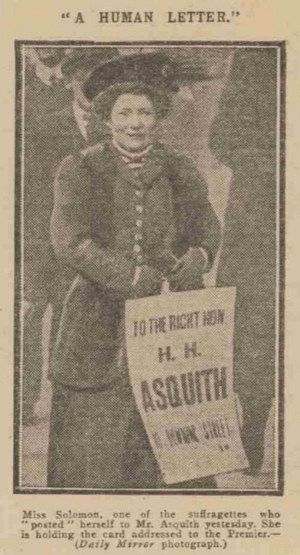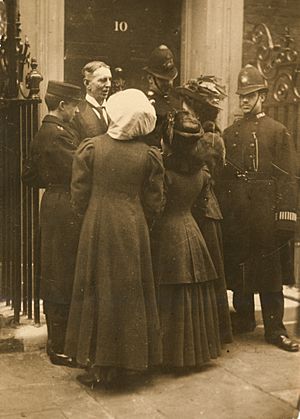Daisy Solomon facts for kids
Quick facts for kids
Daisy Solomon
|
|
|---|---|
 |
|
| Born |
Daisy Dorothea Solomon
1882 Cape Town, Western Cape, South Africa
|
| Died | 1978 (aged 95–96) |
| Known for | suffragette activism, sent as a human letter to the Prime Minister and secretary to equal rights organisations |
| Parents |
|
| Relatives | brother Saul Solomon, Supreme Court judge South Africa brother William Ewart Gladstone Solomon, principal Bombay School of Art India |
Daisy Solomon (1882 - 1978) was a brave activist who fought for women's right to vote. She became famous for a clever stunt: she was "posted" as a human letter to the Prime Minister of the United Kingdom! This was a way to get his attention, as he refused to meet with women who wanted voting rights. Daisy was also a secretary for groups that supported women's rights. She was even arrested and went on a hunger strike for her beliefs.
Contents
Early Life and Family
Daisy Dorothea Solomon was born in 1882 in Cape Town, South Africa. She was one of six children. Her father, Saul Solomon, owned a newspaper and was a politician. He was known for his modern ideas, like supporting a government where all races worked together. This was unusual for his time. He also believed strongly in women's rights and free speech.
Daisy's mother, Georgiana Solomon, was an educator and also a suffragette. She moved from Scotland to South Africa to teach at a new girls' school. Daisy grew up in a family that believed in making society fairer for everyone. Her mother also campaigned for women's rights in South Africa and later in Britain.
The Solomon family moved to Britain in 1888 because Daisy's father was not well. He passed away in Scotland in 1892. Daisy lived in different towns before her family settled in West Hampstead.
Becoming an Activist
Daisy and her mother first joined a group called the Women's Liberal Association. But by 1908, they felt it wasn't doing enough to help women get the right to vote. So, they joined a more active group called the Women's Social and Political Union (WSPU). This group was known for its bold protests and public stunts. They wanted to grab the attention of politicians and the public.
The "Human Letter" Stunt
On February 23, 1909, Daisy Solomon took part in a very unusual protest. She and another activist, Elspeth Douglas McClelland, were "posted" as letters to the Prime Minister at 10 Downing Street. They paid a small fee at the post office. This amazing event made headlines in the Daily Mirror newspaper!
After this, Daisy and other women tried to meet the Prime Minister again. Many women were arrested, including Daisy. This was her first arrest for activism. News of these arrests spread around the world. Newspapers, like the Los Angeles Herald, noted that it was becoming "embarrassing" for the British government to ignore these women.
Daisy Solomon later wrote about her time in prison. She described the simple, hard bed and pillow. Even though it was tough, she said her time in prison felt like a "baptism" to work for women's progress. She even went on a hunger strike while in prison.
Continuing the Fight
Daisy Solomon remained active in the WSPU for several years. Her brother, William E. Gladstone Solomon, was an artist. He even designed a large banner for the WSPU. This banner showed a man and woman, with the words "the old order changeth, giving place to new." It was carried in a big march called the "Prison to Citizenship Procession" in 1910.
By 1915, Daisy had joined another group called the United Suffragists. She continued to work for women's voting rights. She also became secretary for the British Dominions' Women's Citizens Union. She even attended an international conference in Paris in 1923.
Daisy kept fighting for equal voting rights for women, just like men had. In 1928, she became secretary of the Commonwealth Countries League. She spoke about the situation in South Africa, where women did a lot of social work but still couldn't vote in national elections. She explained that British activists should support women in other countries too.
Daisy Solomon returned to South Africa later in her life and passed away there in 1978.
Legacy
Daisy Solomon grew up in a family that truly believed in women's rights. She donated important items to the Women's Service Library (now the Fawcett Library). These included her father's own copy of Mary Wollstonecraft's famous book, Vindication of the Rights of Women. This book argued for women's equality.
Daisy Solomon's own papers were given to the South African library in Cape Town. They are now part of the National Library of South Africa. Her story reminds us of the many brave people who fought for the rights we have today.


